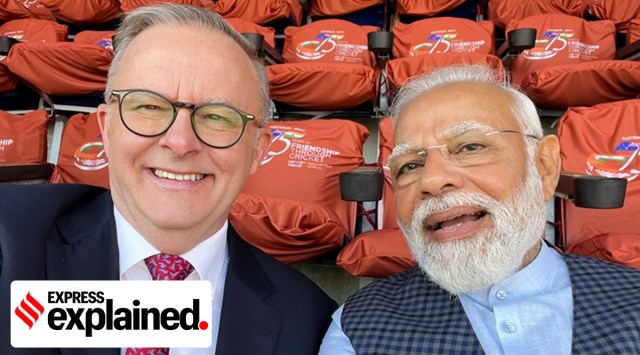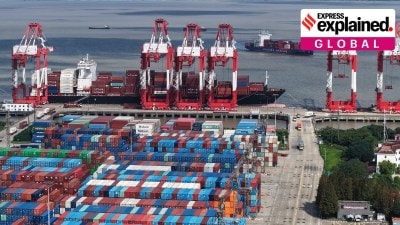“At the heart of this contest is genuine respect, reflecting the affection and friendship between our peoples…On the field, Australia and India are competing to be the best in the world. Off the field, we are co-operating to build a better world,” Albanese, the first leader of his country to make a bilateral visit to India since Malcolm Turnbull in 2017, posted.

The first in-person India-Australia Annual Summit will be held on Friday.
Historical perspective
The India-Australia bilateral relationship has been underpinned by the shared values of pluralistic, Westminster-style democracies, Commonwealth traditions, expanding economic engagement, and increasing high-level interaction.
Several common traits, including strong, vibrant, secular, and multicultural democracies, a free press, an independent judicial system, and English language, serve as the foundation for closer co-operation and multifaceted interaction between the two countries.
The end of the Cold War and beginning of India’s economic reforms in 1991 provided the impetus for the development of closer ties between the two nations. The ever-increasing numbers of Indian students travelling to Australia for higher education, and the growing tourism and sporting links, have played a significant role in strengthening bilateral relations.
With the passage of time, ties evolved in the direction of a strategic relationship, alongside the existing economic engagement. In recent years, the relationship has charted a new trajectory of transformational growth. With greater convergence of views on issues such as international terrorism, and a shared commitment to a rules-based order in the Indo-Pacific region, the two democracies have taken their cooperation to plurilateral formats, including the Quad (with the United States and Japan).
Strategic ties
Story continues below this ad
In September 2014, Australia’s Prime Minister Tony Abbott visited India, and in November that year, Modi became the first Indian Prime Minister to make an official visit to Australia after Rajiv Gandhi in 1986. He also became the first Indian PM to address a joint sitting of the Parliament of Australia.
 Narendra Modi meets Australian PM Tony Abbot
Narendra Modi meets Australian PM Tony Abbot
At the India-Australia Leaders’ Virtual Summit in June 2020, Modi and Prime Minister Scott Morrison elevated the bilateral relationship from the Strategic Partnership concluded in 2009 to a Comprehensive Strategic Partnership (CSP).
Modi and Morrison spoke by phone on three occasions in 2021, and met in person in Washington DC and at the COP26 climate summit in Glasgow. At the 2nd India-Australia Virtual Summit in March 2022, several key announcements were made, including on a Letter of Intent on Migration and Mobility Partnership Arrangement to foster the exchange of skills, and a Letter of Arrangement for Educational Qualifications Recognition to facilitate the mobility of students and professionals.
Prime Ministers Modi and Albanese met thrice last year. There has been a series of high-level engagements and exchange of ministerial visits in 2022 and in 2023. The External Affairs Minister travelled to Australia on February 18, and his Australian counterpart Penny Wong visited from February 28 to March 3. Australia’s Education Minister Jason Clare also visited.
Story continues below this ad
China factor
Ties between Australia and China were strained after Canberra in 2018 banned Chinese telecom firm Huawei from the 5G network. Later, it called for an inquiry into the origins of Covid-19, and slammed China’s human rights record in Xinjiang and Hong Kong. China responded by imposing trade barriers on Australian exports, and by cutting off all ministerial contact.
India has been facing an aggressive Chinese military along the border. New Delhi and Canberra have been assessing the Chinese challenge since 2013.
In a speech at the Centre for Policy Research last year, former Australian envoy Peter Varghese said: “China’s abandonment of hide and bide, its ambition to become the predominant power in the Indo-Pacific if not beyond, its use of economic coercion and its desire to recreate the Middle Kingdom where harmony was hierarchy with China at the top: all of this is leading other countries to balance and constrain China. And India is seen as an important element in these strategies.”
Story continues below this ad
He said “both Australia and India support a rules-based international order”, and that they are partners “in seeking to forge regional institutions in the Indo-Pacific which are inclusive, promote further economic integration, and can help…to manage the tensions…as economic growth across the…region shifts strategic weight and relativities”. The countries’ participation in Quad is an example of their convergence of interests, based on shared concerns.
Wide cooperation
*Economic cooperation: The Economic Cooperation Trade Agreement (ECTA) — the first free trade agreement signed by India with a developed country in a decade — entered into force in December 2022, and has resulted in an immediate reduction of duty to zero on 96% of Indian exports to Australia in value (that is 98% of the tariff lines) and zero duty on 85% of Australia’s exports (in value) to India.
Bilateral trade was US$ 27.5 billion in 2021; with ECTA, there is potential for it to reach around US$ 50 billion in five years.
*People-to-people ties: India is one of the top sources of skilled immigrants to Australia. As per the 2021 Census, around 9.76 lakh people in Australia reported their ancestry as Indian origin, making them the second largest group of overseas-born residents in Australia. To celebrate India@75, the Australian government illuminated more than 40 buildings across the country, and Prime Minister Albanese issued a personal video message.
Story continues below this ad
*Education: The Mechanism for Mutual Recognition of Educational Qualifications (MREQ) was signed on March 2 this year. This will facilitate mobility of students between India and Australia. Deakin University and University of Wollongong are planning to open campuses in India. More than 1 lakh Indian students are pursuing higher education degrees in Australian universities, making Indian students the second largest cohort of foreign students in Australia.
*Defence cooperation: The 2+2 Ministerial Dialogue was held in September 2021, and the Deputy Prime Minister and Defence Minister of Australia visited in June 2022. The Mutual Logistics Support Agreement (MLSA) was concluded during the Virtual Summit in June 2020, and the two militaries held several joint exercises in 2022. Australia will host military operations with India, Japan, and the US in the “Malabar” exercises off the coast of Perth in August, and has invited India to join the Talisman Sabre exercises later this year.
Albanese visited INS Vikrant on Thursday, and declared “there has never been a point in both of our country’s histories where we’ve had such a strong strategic alignment”.
*Clean energy: The countries signed a Letter of Intent on New and Renewable Energy in February 2022 which provides for cooperation towards bringing down the cost of renewable energy technologies, especially ultra low-cost solar and clean hydrogen. During the Virtual Summit in March 2022, India announced matching funds of AUD 10 million for Pacific Island Countries under Infrastructure for Resilient Island States (IRIS) and of AUD 10 million for Pacific Island Countries under International Solar Alliance (ISA).



 Narendra Modi meets Australian PM Tony Abbot
Narendra Modi meets Australian PM Tony Abbot


































